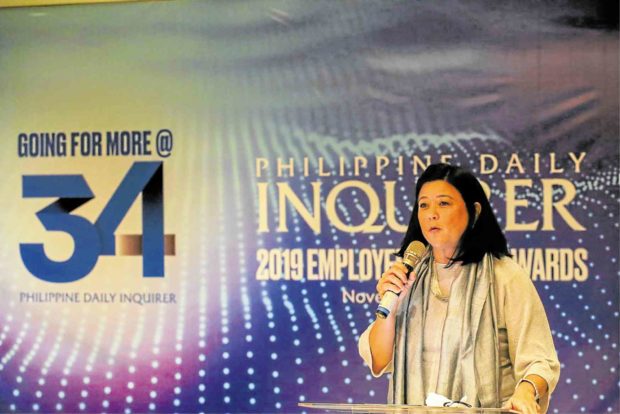The secret to Inquirer’s staying power
It was with “eyes of big exploration” more than two decades ago that a young Alexandra Prieto-Romualdez joined the Philippine Daily Inquirer, then a similarly young newspaper born out of the Filipinos’ yearning for genuine change.
Twenty-five years on, she recalled the ups and downs of the country’s newspaper of record and how the support of its readers has enabled the paper to weather the tough challenges brought on by fickle politics and an uncharted and constantly changing media terrain.
The support need not even be grand gestures, she said, recalling how the Inquirer had resisted and survived the crippling advertising boycott initiated by former President Joseph Estrada.
“This kid wrote to us and sent us P20. He said it was his birthday money, and he was giving it to the Inquirer to fund its journalism,” Prieto-Romualdez recalled.
“[With] the challenges and the disruptions that come our way, at some point you think they are insurmountable,” she said. “I guess it is during those times [that] you can really see the strength of the institution. We are so grateful to the men and women who have helped build the Inquirer. They worked hard at preserving the brand values of balanced news and fearless views. And I think that’s why we have been able to last 34 years: readers have trusted the brand and, more importantly, supported it. We thank them and our other stakeholders from the academe, business, sociocivic and political sphere.”
Article continues after this advertisementFor Prieto-Romualdez, the company’s president and chief executive officer, the Inquirer’s staying power lies not only in its steadfast commitment to tell the story of the Filipino, but also in the surprising courage of its readers to share the paper’s mission to be a catalyst for social progress and change.
Article continues after this advertisementThat mission had been the strong pull for Prieto-Romualdez herself, who joined the Inquirer in 1994 and finally took the helm four years later, when she was 31.
She has seen the Inquirer evolve from black-and-white to colored print, and from a print-only medium to a multimedia platform, an inevitability that has upended the newspaper industry around the globe.
Inquirer chief operating officer Rudyard Arbolado recalled being a witness to that period. The young lawyer joined the company in 2007 as its general counsel. For him, the Inquirer was a viable place that married his three interests: law, finance and technology.
Despite the oft-repeated dire predictions on the death of print, Arbolado said he has stayed on because of his “belief in the Inquirer’s mission.”
While other papers struggle to remain relevant amid the stiff competition posed by online news that can be accessed for free, Arbolado firmly believes it is the quality of the Inquirer’s work that will pull it through.
“The role of print as the chronicler of modern history remains,” he said. “What we need to do is make sure that we have the talent and good people who [keep pushing] our mission.”
Diving into issues that people can connect with is something that the Inquirer does very well, Prieto-Romualdez acknowledged.
“When we come up with reports that address certain flaws in the system, like the recent PhilHealth special reports, or environmental reports, I think people appreciate that,” she said.
Harnessing the power of various platforms, the Inquirer connected with its readers even further, setting up several communication channels through social media and ensuring that its readers would feel that they are part of the change.
Arbolado said this connection and trust has been evident in the rising personal and corporate subscription rates beginning three years ago—a beam of hope in an industry often doomed by bleak prospects.
As Inquirer sets its sights at more years of service, Prieto-Romualdez said Filipinos can expect it to offer more of the same agenda-setting stories it has been known for.
“The Inquirer will continue to invest in people, resources, systems and processes that will allow us to service the readers’ information needs,” she said. “Hopefully, together we will be able to improve the community and help it feel empowered.”

